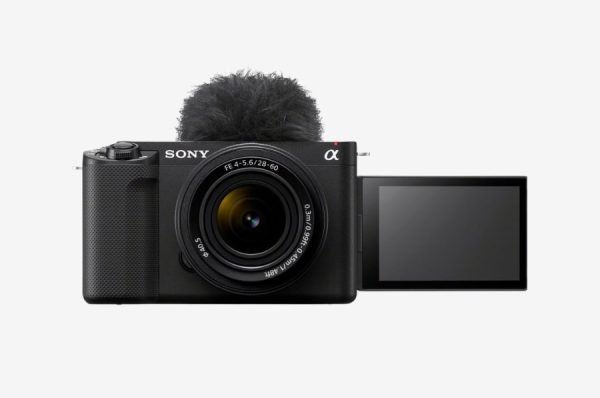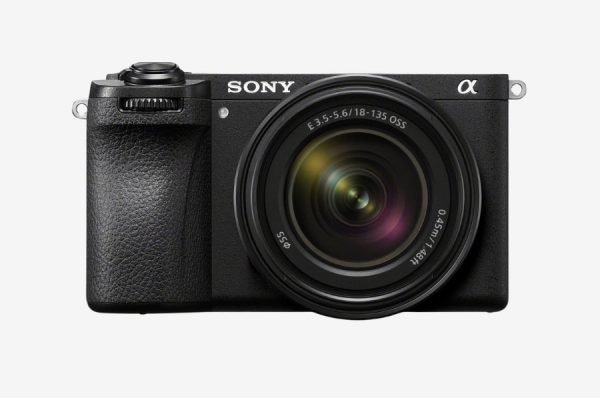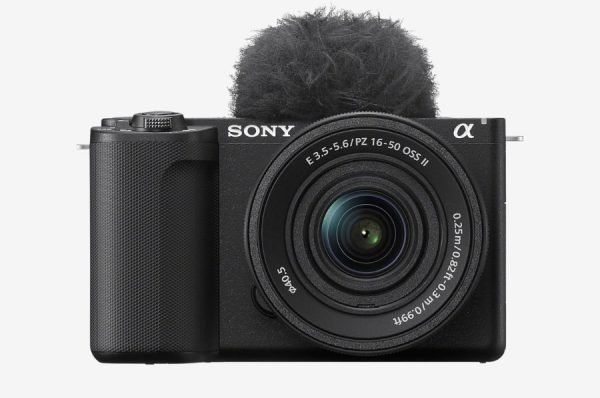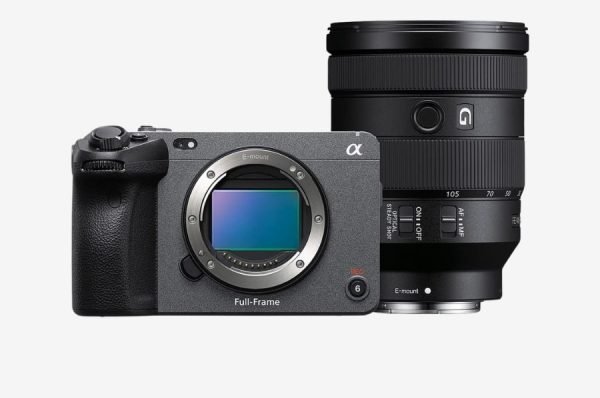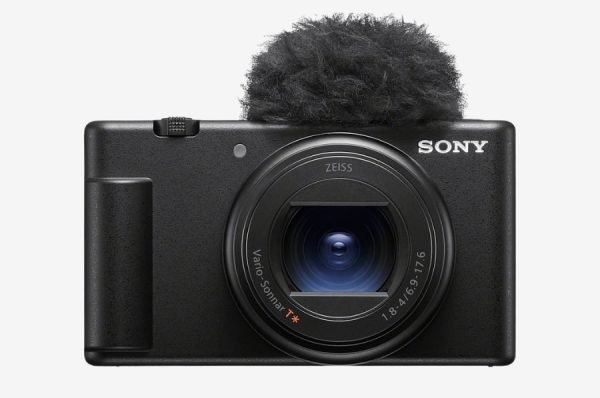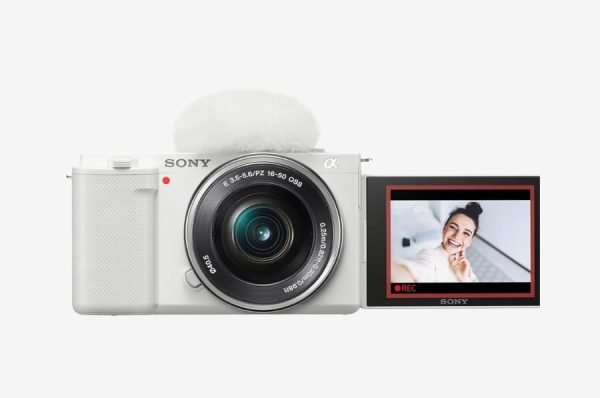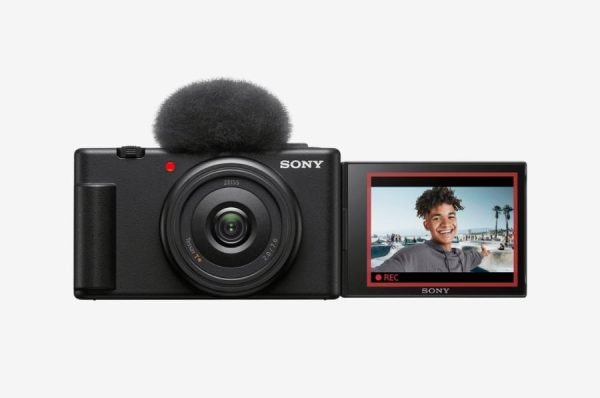The 5 Best Sony Cameras For Vlogging and Content Creators
We’ve tested over 30 Sony Vlog cameras to find the best options for different types of content creators. From the compact ZV-1 II that fits in your pocket to the full-frame ZV-E1 with its exceptional low-light performance, Sony has built cameras that address the specific challenges content creators face. The best Sony vlogging cameras deliver sharp images, clear audio, and reliable stabilization—features that can noticeably improve your content quality
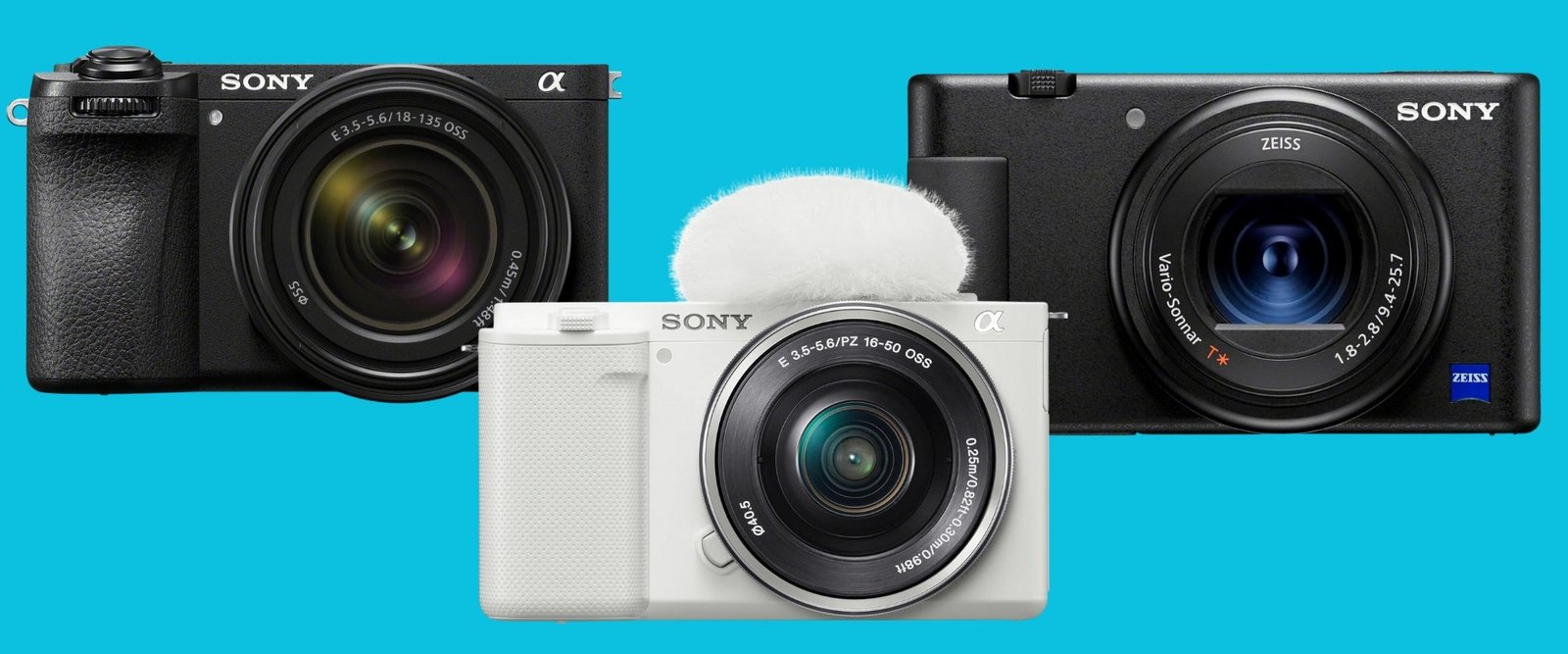
For most people starting out, a phone works perfectly well. But if you’re serious about vlogging—or ready to step up from smartphone recording—Sony offers cameras that deliver better image quality, superior autofocus, and longer battery life than what you’ll get from even flagship phones. Whether you’re filming your first videos or looking to upgrade from a basic setup, we’ve identified the Sony cameras that offer the best combination of features, performance, and value for vloggers in 2025.
Best Sony Vlogging Camera
The Sony ZV-E1 represents Sony’s first attempt at building a full-frame camera specifically for vloggers. This approach shows in the camera’s design choices—from the prominent tally light to the AI-powered auto framing that keeps you centered in the shot even when the camera sits on a tripod. It excels in low-light situations. At the heart of the ZV-E1 sits the same 12-megapixel full-frame sensor found in the much more expensive A7S III. The relatively low megapixel count is intentional—it allows each pixel to capture more light, resulting in cleaner footage in dim conditions. You can shoot usable video at ISO 12800 with minimal grain, making this camera ideal for indoor vlogging or evening content.
The camera’s ISO range extends up to 409,600 in expanded mode, though you’ll rarely need to push it that high. The practical benefit is that you can vlog in challenging lighting without carrying additional lights or struggling with noisy footage. The compact body makes extended shooting comfortable. Weighing just 483 grams, the ZV-E1 is significantly lighter than the 699-gram A7S III. This difference becomes noticeable during long handheld sessions or when mounting the camera on gimbals. The fully articulating touchscreen flips out to the side and rotates 180 degrees, allowing you to frame yourself easily regardless of the camera’s position.
Sony simplified the controls for video-focused work. A single switch toggles between Still, Movie, and S&Q (slow and quick motion) modes, while dedicated buttons handle product showcase and background defocus functions. The visible tally light appears on both the front and top of the camera, so you can see when recording from any angle.
Its stabilization system offers multiple levels of correction. The 5-axis in-body image stabilization works well for basic handheld shooting, but the ZV-E1 goes further with specialized modes. Active mode provides enhanced shake reduction for walking shots, while Dynamic Active mode adds even more stabilization at the cost of cropping your footage. These options let you adapt the stabilization to your shooting style without needing a gimbal in many situations.
The Cinematic Vlog setting automatically configures the camera for 4K recording with black bars that simulate a 2.35:1 aspect ratio. For slow-motion work, the S&Q mode captures up to 240fps in Full HD. The autofocus system tracks subjects intelligently. Sony’s AI processor recognizes and tracks faces, eyes, and bodies, plus animals, birds, vehicles, and even insects. But the standout feature is AI-based auto framing, which automatically crops the frame to keep subjects optimally positioned. You can choose between small, medium, or large crops with adjustable tracking speeds, essentially getting dynamic camera movements when shooting solo with a stationary camera.
Video quality is exceptional for the price. The ZV-E1 records 4K at up to 60fps with 10-bit 4:2:2 color sampling, providing plenty of data for color grading. S-Log 2 and S-Log 3 profiles capture up to 15 stops of dynamic range, giving you flexibility similar to much more expensive cinema cameras. All-Intra recording at up to 600 Mb/s ensures maximum quality for professional post-production work.
Slow-motion options include 4K at 120fps and Full HD at up to 240fps, covering most creative needs without requiring external recorders. Audio quality matches the video capabilities. The built-in 3-capsule microphone automatically adjusts its directionality based on what the camera sees. In Auto mode, it switches between front-facing for self-recording, all directions for ambient sound, and rear-facing for narration. The included windscreen reduces wind noise effectively, though you can add external mics via the 3.5mm input or Multi-interface shoe.
It costs significantly less than comparable cameras. At approximately $2,200 for the body, the ZV-E1 delivers similar image quality to the $3,500 A7S III or $3,900 FX3 while adding. Vlog-specific features those cameras lack. This makes it an excellent choice for serious content creators who need professional video quality without the premium price tag.
The ZV-E1 works well for still photography too, capturing 12-megapixel RAW photos at up to 10fps, though its strength clearly lies in video work.
Best High-End Sony Vlogging Camera
When you’re ready to upgrade your vlogging camera gear, the Sony α6700 offers the best combination of image quality, stabilization, and price. Released after a four-year gap in Sony’s A6000 series, this hybrid camera bridges the world between serious photography and professional video work without the bulk of full-frame systems.
It can shoot extremely high-quality video. The α6700’s new 26MP back-illuminated CMOS sensor pairs with Sony’s BIONZ XR processor and dedicated AI processing unit to deliver 4K recording at 60fps using the full sensor width, oversampled from 6K capture for exceptional detail. This represents a massive step up from cameras that simply crop their sensors for 4K recording.
For slow-motion enthusiasts, the α6700 can record 4K at 120fps with a 1.58x crop—a capability found in very few cameras at this price point. The camera supports advanced color profiles including S-Log3, S-Cinetone, and HLG, plus 10-bit 4:2:2 color sampling for serious post-production work.
It has in-body stabilization. The α6700’s 5-axis in-body image stabilization (IBIS) works with both stabilized and non-stabilized lenses, making virtually any lens in your collection viable for smooth video work. Active SteadyShot mode applies a 1.13x crop while moving that crop within the frame for enhanced stabilization. The system also records gyroscopic data that works with Sony’s Catalyst software for further stabilization adjustments.
It has a larger sensor. The APS-C sensor in this camera is larger than the one found in the ZV-1 II and significantly larger than what you get in phones and action cameras. As a result, it produces less noise in low-light situations, has a higher dynamic range, and creates a more professional-looking image overall. The ISO range extends from 100-32000, expandable to 50-102400, giving you flexibility in challenging lighting conditions.
The autofocus system is remarkably intelligent. With 759 phase-detection points covering 93% of the frame, the α6700 uses human pose estimation technology to track subjects with unprecedented accuracy. Beyond human tracking, it recognizes animals, birds, insects, cars, trains, and airplanes, with customizable settings for prioritizing eyes, heads, or entire bodies.
Unlike its predecessors, the α6700 features a fully articulating touchscreen that flips out to the side, making self-recording significantly easier. The 3-inch display includes a Sunny Weather mode for outdoor visibility, and Sony has added a front command dial that makes the camera more intuitive to operate.
You can swap out lenses. One of the biggest advantages of the α6700 is compatibility with Sony’s extensive E-mount ecosystem, including both APS-C and full-frame lenses. For vloggers, the 15mm f/1.4 G lens creates an excellent compact setup, while the Sigma 18-50mm f/2.8 offers a versatile constant aperture zoom in a remarkably small package.
It’s more expensive but offers exceptional versatility. At 493g with battery, the α6700 maintains portability while delivering professional capabilities. It’s perfectly suited for hybrid content creators who need both exceptional stills and video capability, particularly travel vloggers seeking professional quality without full-frame bulk. The camera represents one of the most capable APS-C options available for creators who refuse to compromise on either photo or video performance.
Best Mid-Range Sony Vlogging Camera
The Sony ZV-E10 II fixes the most significant problems with its predecessor while maintaining the features that made it popular with beginning vloggers. This updated model delivers substantial improvements in usability and video capability without overwhelming newcomers to interchangeable lens cameras.
The touchscreen finally works properly for video. The original ZV-E10’s limited touch functionality forced you to navigate menus with physical buttons while trying to frame yourself in the flip-out screen. The ZV-E10 II supports full touchscreen menu navigation, and the interface automatically rotates between horizontal and vertical orientations—essential for creating content across different social media platforms.
It records higher-quality video than the original. The ZV-E10 II can capture 4K video at 60fps using 5.6K oversampling for sharper detail. More importantly for serious content creators, it supports 10-bit 4:2:2 color recording internally, providing significantly more flexibility during color grading. The camera also includes advanced color profiles like S-Log3 and S-Cinetone, plus the ability to load custom LUTs.
Battery life is dramatically better. The ZV-E10 II can record continuously for up to 2 hours and 14 minutes in 4K mode, compared to about an hour for the original model. This improvement alone makes the camera much more practical for longer recording sessions.
The ZV-E10 II maintains the same compact, lightweight design as its predecessor. The fully articulating 3-inch LCD flips out to the side for easy self-recording, and Sony has upgraded the top controls with a proper three-way mode switch instead of the previous model’s single button. A tally light around the LCD clearly indicates when you’re recording.
Lens compatibility opens up creative possibilities. As part of Sony’s E-mount system, the ZV-E10 II works with hundreds of available lenses. You can start with the included 16-50mm kit lens and add telephoto, wide-angle, or portrait lenses as your needs evolve. The updated kit lens maintains autofocus while zooming, which helps when you need to adjust framing during recording.
It lacks in-body stabilization. Unlike the more expensive Sony α6700, the ZV-E10 II doesn’t include IBIS. This limitation means you’ll need to rely on lens-based optical stabilization (available in lenses like the kit 16-50mm OSS) or the camera’s electronic Active mode, which crops the image slightly. For walking shots, combining an optically stabilized lens with Active mode produces acceptable results, though it won’t match the smoothness of cameras with dedicated stabilization systems.
Who should buy it: The ZV-E10 II suits beginner content creators who want room to grow. Its dedicated vlogging features—Product Showcase setting, Background Defocus button, and improved autofocus with 759 detection points—address the specific needs of video creators. The 10-bit recording capability and LOG profiles provide advanced options that become useful as your editing skills develop.
Best Sony Camera For Cinematic Vlogging
The Sony FX30 brings professional cinema capabilities to content creators without the expense of higher-end models like the FX3 or FX6. This APS-C cinema camera uses the same design philosophy as Sony’s professional film equipment, but packages it in a more affordable format that serious vloggers and filmmakers can actually consider.
It delivers true cinema-quality color. The FX30 uses S-Cinetone, the same color science found in Sony’s VENICE cinema cameras. This color profile produces natural skin tones and smooth highlight transitions without requiring complex color grading. Unlike standard camera profiles that need extensive post-processing, S-Cinetone delivers professional-looking footage straight out of the camera.
For advanced users, S-Log3 captures over 14 stops of dynamic range, giving you exceptional flexibility in post-production. You can also import up to 16 custom LUTs for on-set monitoring or embed them directly into your footage.
Video recording capabilities exceed most consumer cameras. The FX30 records 4K at 60fps using the full width of its 6K sensor, producing exceptionally detailed footage. It supports 10-bit 4:2:2 color sampling in both XAVC HS and XAVC S-I formats—specifications typically found in cameras costing twice as much.
Slow-motion options include 4K at 120fps (with a 1.6x crop) and Full HD at 240fps. The 5-axis in-body stabilization includes an Active Mode that’s effective enough to eliminate the need for a gimbal in many shooting scenarios.
The body is built for professional use. Sharing the same physical design as the more expensive FX3, the FX30 features a flat-top layout with five 1/4″-20 threaded mounting points for accessories. At 646g, it’s lighter than the FX3’s 715g while maintaining the same durable magnesium alloy construction.
Dedicated record buttons on both the top and front make operation intuitive, while the fully articulating screen flips out for various shooting angles.
Dual base ISO provides flexibility in different lighting conditions. The FX30 offers base ISO settings at both 800 and 2500, with nearly identical noise performance at either setting. This dual-gain design means you can shoot in bright daylight or dim interior conditions without significant image quality penalties.
Three recording modes take advantage of this capability: Flexible ISO for simple operation, Cine EI for maximum dynamic range, and Cine EI Quick for automatic switching between base settings.
Heat management allows extended recording sessions. An active cooling fan and heatsink system prevent overheating during long shoots—a common limitation in smaller cameras. The USB terminal supports live streaming, expanding the camera’s versatility beyond traditional video production.
The FX30 is ideal for content creators who need cinema-quality output, filmmakers seeking a compact B-camera, or anyone moving from consumer to professional equipment. While it costs more than traditional vlogging cameras, it provides professional filmmaking features at a fraction of the cost of full cinema cameras.
Best Compact Sony Vlogging camera
When you’re ready to step up from smartphone recording but don’t want to spend more than $900, the Sony ZV-1 II offers the most beginner-friendly features in Sony’s vlogging lineup. Priced at USD 899.99, this compact point-and-shoot camera removes the complexity of interchangeable lenses while delivering professional-looking results.
It’s built for people new to cameras. Sporting a 1-inch, 20.1-megapixel Exmor RS CMOS sensor, the ZV-1 II handles most technical decisions automatically. The upgraded 18-50mm f/1.8-4.0 lens provides a much wider field of view than the original ZV-1, making it substantially easier to frame yourself when recording at arm’s length. This wider angle eliminates the awkward positioning that plagued the original model.
The wider lens makes selfie framing much easier. The ZV-1 II features an 18-50mm equivalent F1.8-4.0 lens—a significant improvement over the original’s 24-70mm lens that made self-recording awkwardly tight. At 18mm, you can comfortably frame yourself at arm’s length, or use digital stabilization with a 1.33x crop for approximately 24mm field of view. This wider angle also gives you more flexibility for group shots and scenic backgrounds.
It captures sharp footage with a larger sensor. The 20MP 1-inch Stacked CMOS sensor delivers excellent image quality even in challenging light. That’s significantly larger than smartphone sensors, resulting in better low-light performance and more natural background blur when you want to separate yourself from busy backgrounds.
The ZV-1 II records 4K video at up to 30fps, though slow-motion recording drops to 1080p. Unlike its predecessor, this version relies on digital stabilization rather than optical stabilization, which crops the frame slightly but works effectively for walking shots and handheld recording.
Product Showcase mode eliminates focus hunting. The autofocus system combines 315 phase-detection and 425 contrast-detection points with Sony’s real-time tracking. The ingenious Product Showcase mode automatically shifts focus from your face to any object you hold up to the camera—perfect for product reviews, cooking demonstrations, or unboxing videos. Multi-face Recognition mode automatically adjusts aperture when multiple people enter the frame, keeping everyone in focus.
The touchscreen makes operation simple. Weighing just 292g and measuring 106mm at its longest side, the ZV-1 II fits easily in a jacket pocket. The fully articulating touchscreen flips out for self-recording and handles most camera operations through touch controls. You can even zoom using onscreen icons, complementing the physical zoom rocker.
Audio quality exceeds most compact cameras. The intelligent 3-capsule microphone offers selectable directionality with Auto, Front, All Directions, or Rear settings. In Auto mode, the microphone uses face detection to determine optimal sound pickup. The included windscreen reduces wind noise for outdoor recording. While external audio remains recommended for professional results, the built-in mic performs much better than typical compact cameras.
The ZV-1 II works best for casual vloggers, travelers, and content creators who want quality results without complex settings. It excels in automatic modes, making it ideal for users who prefer to focus on content rather than camera operation. Its pocket-friendly size and automated features also make it an excellent backup camera for established creators.
Best Budget Sony Vlogging Camera
For creators seeking an entry into Sony’s interchangeable lens ecosystem without spending a fortune, the ZV-E10 presents a compelling budget option. Currently priced at $649.99 (down from the original $749.99), this camera delivers the core features vloggers need while keeping costs reasonable.
It records detailed 4K video with some limitations. The ZV-E10 uses a 24.2MP APS-C sensor that captures good-looking 4K footage, though there are trade-offs to consider. When shooting 4K at 30fps, the camera applies a 1.23x crop, which can make framing tighter than you might expect. Switch to 24fps and you get the full sensor width, which matters if you’re trying to fit yourself and a friend in the frame.
The flip screen works well, but the touchscreen has issues. The 3-inch screen flips out to the side for self-recording and includes basic touch functionality. However, the touchscreen isn’t particularly responsive, so you’ll often find yourself using the physical buttons instead. The camera includes the same vlogging-specific features found in pricier models: a dedicated record button, background defocus toggle, and Product Showcase mode.
Stabilization requires workarounds. Unlike the newer ZV-E10 II, this model lacks in-body stabilization. You can use lenses with Optical SteadyShot or enable electronic Active stabilization, though that adds another crop to your footage. For the steadiest results, consider recording without stabilization and using Sony’s Catalyst software in post-production.
The autofocus system performs well. With 425 phase-detection points covering 84% of the frame, the ZV-E10 delivers reliable focus tracking. Real-time eye AF works for both humans and animals, keeping subjects sharp even when they move around the frame.
Battery life exceeds expectations. You’ll get approximately 440 shots per charge or about 125 minutes of continuous video recording. That’s better performance than many cameras in this price range.
It offers growth potential. The ZV-E10 works with Sony’s extensive E-mount lens collection, allowing you to start with the kit lens and upgrade over time. More advanced shooters can take advantage of S-Log2, S-Log3, and HLG profiles for greater flexibility in post-production.
The ZV-E10 works best for creators who want interchangeable lens flexibility without paying premium prices. It’s particularly suitable for beginners building their first serious camera system or as a backup camera for established creators. While it lacks some conveniences found in newer models, it delivers solid video quality and room for growth as your skills develop.
Best Entry-Level Sony Vlogging Camera
At $499, the Sony ZV-1F offers the most affordable entry into Sony’s vlogging camera lineup. This ultra-budget option makes sense for creators who want better image quality than smartphones without spending significantly more money.
It has an ultra-wide fixed lens. The ZV-1F features a fixed 20mm equivalent f/2 lens with a 94-degree field of view. This wider perspective means you can easily fit yourself in the frame when recording at arm’s length, eliminating the need for selfie sticks in most situations. The bright f/2 aperture also provides pleasant background blur when you want to separate yourself from the background. Unlike other ZV cameras that start at 24mm, this 20mm lens gives you more flexibility for travel vlogs and solo content creation.
It’s extremely compact and lightweight. Measuring just 4.15 x 2.36 x 1.82 inches and weighing 0.5 pounds, the ZV-1F fits comfortably in one hand. The small bump on the front provides an adequate grip, while the slim lens design keeps the camera genuinely pocket-friendly.
Video quality is good for the price. The ZV-1F records 4K video at 30fps with 8-bit 4:2:0 color sampling. You can shoot in S-Log2 or S-Log3 profiles for more flexibility in color grading. The camera lacks optical stabilization, but the digital Active SteadyShot works effectively for handheld recording and walk-and-talks. This electronic stabilization crops the frame slightly but delivers stable results.
Controls are simple and one-handed friendly. All controls sit on the right side of the camera. The 3-inch fully articulating touchscreen flips out to the side for easy self-recording. The top of the camera includes a dedicated Background Defocus button that instantly blurs backgrounds with the touch of a button.
Connectivity is modern but battery life is limited. The camera includes USB-C for charging, Micro HDMI for output, and a 3.5mm port for external microphones. USB-C charging means you can use standard cables rather than proprietary ones. However, battery life is modest at approximately 60 minutes of 4K recording. You can transfer files to your phone using Sony’s Imaging Edge Mobile Plus app.
The ZV-1F works well for TikTok creators wanting better quality than smartphones, Instagram content producers who need ultra-wide selfie angles, beginning YouTubers on tight budgets, and anyone transitioning from phone recording to dedicated camera equipment
Frequently Asked Question About Sony Cameras For Vlogging
What is the best Sony camera for vlogging?
The best Sony camera for vlogging depends on your specific needs and budget. For beginners, the Sony ZV-1 II offers great value, while more advanced users might prefer the Sony ZV-E1 for its full-frame sensor and professional features. The Sony a6700 is an excellent mid-range option for those wanting both photo and video capabilities.
How does Sony's autofocus system benefit vloggers?
Sony's autofocus system is industry-leading, offering real-time tracking and eye AF for humans and animals. This ensures that vloggers stay in focus while recording, even when moving around or presenting objects to the camera. Features like Product Showcase mode automatically shift focus to objects held up close, which is ideal for product reviews or demonstrations.
Do Sony vlogging cameras offer good stabilization?
Many Sony vlogging cameras offer excellent stabilization options. While some models like the ZV-E1 and a6700 feature in-body image stabilization (IBIS), others rely on electronic stabilization or lens-based optical stabilization. Active SteadyShot mode in cameras like the ZV-1 II provides enhanced stabilization for walking shots, though it may apply a slight crop to the frame.
What video features do Sony vlogging cameras typically include?
Sony vlogging cameras often include 4K video recording, high frame rate options for slow-motion, and advanced color profiles like S-Log3 and HLG. Many models offer 10-bit 4:2:2 color sampling for greater flexibility in post-production. Features like Background Defocus buttons and Cinematic Vlog settings cater specifically to content creators' needs.
Are Sony vlogging cameras best for beginners?
Yes, Sony offers several vlogging cameras suitable for beginners. Models like the ZV-1 II and ZV-E10 provide user-friendly interfaces and automatic modes that make it easy for newcomers to achieve professional-looking results. These cameras also offer room for growth, with more advanced features that users can explore as their skills develop.

